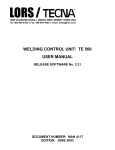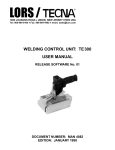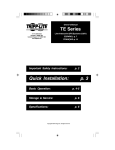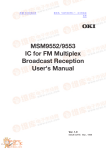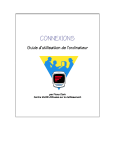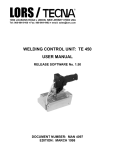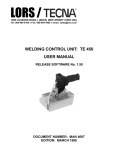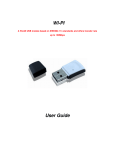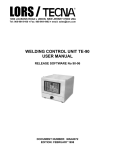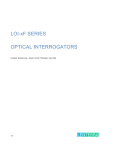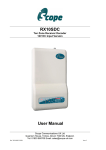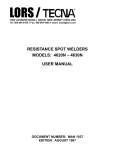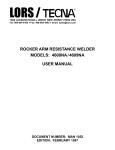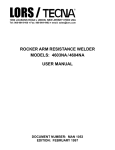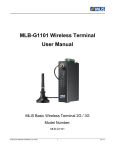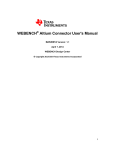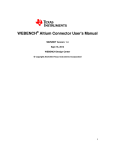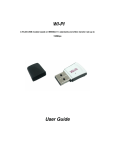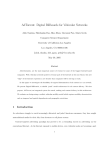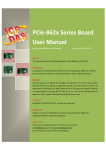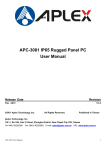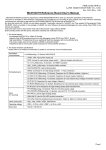Download Welding Control Unit TE-600
Transcript
LORS / j 1090 LOUSONS ROAD ♦ UNION, NEW JERSEY 07083 USA Tel: 908-964-9100 ♦ Fax: 908-964-4492 ♦ email: [email protected] WELDING CONTROL UNIT: TE 600 USER MANUAL RELEASE SOFTWARE No. 6.08 EDITION: JUNE 2007 This page is intentionally left blank. 2 / 42 TABLE OF CONTENTS TOPICS PAGE TE600 WELDING CONTROL UNIT 4 MAIN TECHNICAL DATA 4 CONTROL UNIT SWITCH-ON 5 CONTROL UNIT PROGRAMMING 6 DESCRIPTION OF THE PROGRAM PARAMETERS 8 SETUP MENU 11 DESCRIPTION OF THE SETUP MENU PARAMETERS 11 STEPPER MENU 13 WELDING SPOTS COUNTER FUNCTION 18 INSTALLATION MENU 19 DESCRIPTION OF THE INSTALLATION MENU PARAMETERS 19 DIAGNOSTICS MENU 20 FACTORY RESERVED MENU 21 PANEL CONTROLS 22 PANEL LEDs 23 RUN 23 SELECTION OF THE WORK PROGRAM 24 DESCRIPTION OF THE WORK CYCLE 26 EXAMPLES OF WELDING PROGRAMS 27 READING OF THE WELDING CURRENT AND CURRENT LIMITS 30 THERMOSTAT/PRESSURE SWITCH INPUT FUNCTION 31 SERIAL INTERFACE RS-232 32 INTERFACE FOR PROPORTIONAL VALVE 34 LOCK/END AND WRONG SIGNALS FUNCTIONING 35 DOUBLE STROKE FUNCTION 36 LIST OF MESSAGES 37 DESCRIPTION OF SIGNALS ON TERMINAL BOARD 40 3 / 42 WELDING CONTROL UNIT TE 600 The TE600 is a microprocessor-based welding control unit for resistance welders in inverter technology. The task of the welding control unit is to manage the welder's components, in particular the IGBT power booster unit, which regulates the welding current. It is possible to store up to 63 different welding programs, all of which can be directly recalled from an external device. Each program comprises 22 programmable parameters that describe the work cycle. In addition to the basic 4-stage welding cycle, the control unit allows the running of welding processes with pre-welding current, post-welding current, slopes and pulses. The TE600 works in constant current mode, it visualizes the weld current and controls the current supplied with settable limits. 2 1 2 3 4 MADE IN ITALY MAIN TECHNICAL DATA • • • • • • • • • • • • • • • • • • Simplified programming by 6 keys and alphanumeric LCD. Inverter command with IGBT at medium frequency 1000 Hz. Storage of 63 welding programs, all of which are recallable from PLC, PC, etc. 22 programmable parameters for each program. Stepper function for compensating the electrodes’ wears with programmable curve. Weld times adjustable in 1ms increments. Visualization of the welding current in kA and limits of the welding current. Automatic double stroke function (for the applicable welders). Proportional valve for controlling the welding pressure. Welds-performed counter. Single and automatic cycle. WELD / NO WELD function. Control of 4 solenoid valves 24 Vdc Max. 7.2 W with output protected against short circuit. Welding current limits with output for signalling out-of-limits welds. Outputs for interfacing with external devices (Interlock/End cycle). Automatic voltage compensation. Five languages can be selected. Possibility of updating the control unit hardware. 4 / 42 CONTROL UNIT SWITCH-ON As soon as the welding control unit is turned on, the display shows the primary mains frequency and the software version of the program. SUPPLY FREQUENCY 50 Hz. TECNA TE600 6.08 WELD CONTROL UNIT After a few seconds, the TE600 switches to standby status. PUSH KEY[//] RESTART TO CONTINUE Press the restart key for one second to enable the controls and the outputs of the control unit. It must be pressed every time the control unit is powered. When the key is pressed all the devices connected to the VAUX are powered such as for example the double stroke valve and then the procedure for charging the battery of the capacitors is activated. k Before pressing the key it is important to check that it will not cause injury/damage to people or equipment. CAPACITOR SUPPLIED ...PLEASE WAIT.... It takes about 20 seconds for the device to charge the capacitors and be ready either to begin the welding operations or program the values of the parameters. On powering up the control unit and before starting any welding operations, first program the welding data and set some general operating parameters of the welder. 5 / 42 CONTROL UNIT PROGRAMMING To begin the programming operations, turn the key in the PROG position and be aware of some of the fundamental features of the control unit. TE600 VER. 6.08 > PROGRAM DATA SETUP MENU FEATURES MENU The programming parameters of the control unit are divided into different menus: _ PROGRAM DATA _ SETUP MENU _ STEPPER MENU _ FEATURES MENU _ DIAGNOSTIC _ FACTORY RESERVED MENU Use keys d and f to select the desired menu, identified by symbol ">" next to the caption. Use keys g and h to enter and exit the menu whereas you should use keys a and s to set the parameters. The "Program DATA" menu contains all the parameters associated with the welding cycle, the times and the currents by means of which to carry out the welding process. PROGRAM DATA > PROGRAM NUMBER WORK MODE SQUEEZE 1 01 IK 30 The first choice to make is the number of the program to be used. Choose among the 63 storable programs using the a and s keys. Then proceed with the next parameters moving with the d and f keys, adjusting the desired value always using the a and s keys. As such all the parameters will be set to the desired value for carrying out the welding process. Keep in mind that there is no need to confirm the set data item that is stored automatically after the adjustment. Parameters can have several values, according to the type of parameter. The minimum and maximum limits of each parameter are shown in the following table. 6 / 42 PROGRAM DATA PARAMETERS TABLE PARAMETER DESCRIPTION VALUE RANGE PROGRAM N. PROGRAM NUMERIC SELECTION WORK MODE WORK MODE STROKE DUAL STROKE MODE 1 SQUEEZE 1 1ST SQUEEZE TIME 01 – 99 cycles 2 SQUEEZE * SQUEEZE TIME 01 – 99 cycles 3 FORGING * FORGE DELAY 00 – 99 cycles 4 PRESSURE * WELDING PRESSURE 00.5 – 10.0 bar 5 PRE-WELD PRE-WELD time 0000 – 1000 ms 6 PRE-CURRENT PRE-WELD CURRENT 000.3 – 120.0 kA 7 COLD T. 1 COLD TIME 1 0000 – 1000 ms 8 SLOPE UP SLOPE UP TIME 000 – 500 ms 9 WELD 1 WELDING TIME 0001 – 1000 ms 10 CURRENT 1 WELDING CURRENT 000.3 – 120.0 kA 11 COLD T. 2 COLD TIME 2 0000 – 1000 ms 12 N. OF PULSES PULSES 13 WELD 2 SECOND WELDING TIME 0000 – 1000 ms 14 CURRENT 2 SECOND WELDING CURRENT 000.3 – 120.0 KA 15 SLOPE DOWN SLOPE DOWN TIME 16 COLD T. 3 COLD TIME 3 0000 – 1000 ms 17 POST-WELD POST-WELD TIME 0000 – 1000 ms 18 POST-CURR POST-WELD CURRENT 000.3 – 120.0 kA 19 HOLD HOLD TIME 03 - 99 cycles 20 OFF TIME DWELL TIME 00 - 99 cycles 21 CURR MIN. MIN. LIMIT IN CURRENT 000.3 – 120.0 kA 22 CURR MAX. MAX. LIMIT IN CURRENT 000.3 – 120.0 kA 01 - 63 IK SHORT 0–5 000 – 500 ms (*) _ In order to view these parameters in the welding program they must be activated in the installation menu (see specific section). There are few special conditions: • If OFF TIME is set to (0), the welding control unit will work in single cycle. • When parameters PRE-WELD and/or WELD 2 and/or POST-WELD are set to (0), said cycles will not be run. 7 / 42 DESCRIPTION OF THE PROGRAM PARAMETERS As far as the parameters that indicate times expressed in milliseconds are concerned, the mains frequency (50/60 Hz) does not change the duration of the set time whereas for all those parameters that indicate times expressed in periods, also called mains cycles, the main frequency determines the duration of one period: Mains frequency of 50 Hz 1 period = 20 ms Mains frequency of 60 Hz 1 period = 16.6 ms WORK MODE This parameter defines the mode for adjusting the welding current at constant current (IK). SQUEEZE 1 If a pneumatic circuit is present with low-pressure squeeze, such time is that which determines duration of the squeeze at low pressure, i.e. the interval of time that elapses from the beginning of head descent to the application of the welding force. The set value must be long enough to allow electrodes to reach the workpiece to be welded. In a standard pneumatic circuit, such time is the interval from the beginning of the head descent to beginning of the welding. The set value must be long enough to allow the electrodes to achieve proper clamping force, before the welding begins. During the first squeeze time, it is possible to end the cycle if the start cycle signal is deactivated. the the the the the SQUEEZE The SQUEEZE determines the closing time of the electrodes, i.e. the time interval between the beginning of the closing of the electrodes and the beginning of the weld. The set value must be long enough to permit the electrodes to reach the workpiece to be welded and to attain the correct clamping force before the weld begins. An inadequate adjustment of such time produces sparks among the electrodes and the sheet when the welding begins, causing quality inconsistencies. If the start cycle signal is deactivated, during the squeeze time, the sequence is interrupted. FORGE DELAY The FORGE DELAY parameter is used exclusively with pneumatic circuits that have a forging function capability. Such function permits increasing the electrode force during the welding cycle. The parameter describes the time that elapses from the beginning of the welding process to the application of the forging force onto the electrodes by means of solenoid valve EV3. If the value is set to zero the forging function is disabled and valve EV3 will be activated at the beginning of the squeezing phase. PRESSURE This parameter, expressed in bar or psi, expresses the welding pressure value. The set value must be such that it guarantees a proper clamping force during the welding cycle. An inadequate adjustment of such value produces sparks between electrodes and sheet when the welding begins. PRE-WELD The PRE-WELD parameter indicates the duration of a current flow that can be carried out before the welding process so as to pre-heat the workpiece to be welded. If this parameter is set to (0), the preweld will not be carried out. Pre-weld is carried out with a current adjustment equal to that stated in the PRE-CURR parameter. 8 / 42 PRE-CURRENT The value expressed in this parameter indicates the current used for carrying out the PRE-WELD. COLD TIME 1 This parameter indicates the time that elapses from the PRE-WELD to the weld. If the PRE-WELD is deactivated, this cooling time is not carried out. SLOPE UP The SLOPE UP parameter describes the time for attaining the programmed welding current value. The starting value of this slope always corresponds to the minimum current, whereas the final value corresponds to the current value set at parameter CURRENT 1. The slope inclination is automatically calculated by the microprocessor based on the set values. The SLOPE UP time is added to the welding time. WELD 1 This parameter indicates the welding current flow duration. It is carried out with the same power value set at parameter CURRENT 1. When the pulse operating mode is activated, this parameter indicates the duration of each pulse. CURRENT 1 The value indicated in CURRENT 1 shows the current adjustment that is used for carrying out the welding process. COLD TIME 2 This parameter indicates the time that elapses from WELD 1 to the pulses, where applicable, or to WELD 2. N. PULSES This parameter indicates the number of pulses used for carrying out the welding process. The duration of each pulse corresponds to the time set in parameter WELD 1. WELD 2 This parameter indicates the duration of the flowing of a second weld current, which will be run at a power value equivalent to the one indicated in parameter CURRENT 2. CURRENT 2 The value expressed in CURRENT 2 indicates the current adjustment used for carrying out WELD 2. SLOPE DOWN This parameter is a welding time that is added at the end of the welding process during which the weld current decreases, as compared to the value set during the last weld that comes before said time, down to the minimum value. The slope inclination is automatically calculated by the microprocessor based on the set values. The SLOPE DOWN time is always added to the welding time. COLD TIME 3 This parameter indicates the time that elapses from the previous welding time and the POST-WELD time. If the POST-WELD parameter is not programmed, said time is not run. 9 / 42 POST-WELD This parameter indicates the duration of the flowing of the POST-WELD current, which will be run at a power value equivalent to the one indicated in parameter POST-CURR. POST-CURRENT The value expressed in POST-CURR indicates the current adjustment with which the POST-WELD is run. HOLD This parameter indicates the time that elapses from the end of the welding process to the opening of the electrodes. It allows a quicker cooling of the welding spot and prevents the spot from being stimulated before being properly cooled. OFF-TIME This parameter indicates a welder wait time, namely the one that elapses from one welding cycle to the next one when the welder is working in automatic cycle. When this value is set to zero, the welder always works in single cycle; if it is set to another value, the welder will work in the automatic cycle. When the welder works in single cycle, the control unit carries out a single welding cycle each time it receives a start cycle signal. When the welder works in automatic cycle, the welder goes on executing welding cycles until the start cycle signal is released. MIN CURRENT This parameter fixes a minimum current value. For each weld, the TE600 monitors that the welding current supplied by the welder is higher than the value set at this parameter; if it is lower, an error condition occurs (see the relevant paragraph). If this parameter is actually set for the same value of the parameter “MAX CURRENT” the current limits control is disabled. MAX CURRENT This parameter fixes a maximum current value. For each weld, the TE600 monitors that the welding current supplied by the welder is lower than the value set at this parameter; if it is higher, an error condition occurs (see the relevant paragraph). If this parameter is actually set for the same value of the parameter “MIN CURRENT” the current limits control is disabled. 10 / 42 SETUP MENU In the SETUP menu it is possible to activate certain functions that modify the functionality of the control unit. SETUP > LANGUAGE ENG STOP BAD SPOTS 0 SPOTS MAX 00000 SETUP MENU PARAMETERS TABLE PARAMETER DESCRIPTION VALUE RANGE LANGUAGE Language for parameter description ITA-ENG-ESP-DEU-FRA STOP BAD SPOTS Number of spots for out-of-limit stop 0-9 SPOTS MAX Maximum number of spots START 1 PRG Start cycle 1 program 00 - 63 START 2 PRG Start cycle 2 program 01 - 63 PRINTER Printing of weld data ON - OFF PRINTER SPOTS Printing of welding spots 00000 - 60000 ALL - GOOD - BAD DESCRIPTION OF THE SETUP MENU PARAMETERS LANGUAGE Use the LANGUAGE parameter to select in which language the control unit should visualize the programming parameters. STOP BAD SPOTS This parameter permits programming the control unit so that it stops when welding spots are performed with current values that are beyond the limits set in the weld program. The set value indicates the number of consecutive "out-of-limits" welding spots after which the machine stops. The limit error occurs when a welding spot is carried out with values either higher or lower than the limits set in parameters “MINIMUM CURRENT (MIN CURR)” and “MAXIMUM CURRENT (MAX CURR)”. To set the value use keys a and s ; the value can be set from (0) to (9). When the value is set to zero, this function is disabled therefore the welder does not stop even in case of "out-of-limits" welding spots. SPOTS MAX This parameter indicates the maximum number of welding spots. The function is to allow the operator to run the desired number of welding spots. When the pre-set number of welds is attained, the control will stop welding. If this parameter is set to zero the function is disabled. START 1 PRG This parameter indicates the program number to be run when the cycle is activated via the start cycle 1 command. The value of the program also includes (0) which, if set, allows the control unit to work with the program that is active in the setting. 11 / 42 START 2 PRG This parameter indicates the program number to be run when the cycle is activated via the start cycle 2 command. PRINTER (with optional card) This parameter enables/disables the printing both of the values of the welding parameters that is carried out by switching the key to WORK position and the values of the run weld, at the end of each spot. PRINTER SPOTS (with optional card) If the previous parameter is activated the user may choose, by means of this parameter, which welding spots to print. It is possible to print all spots (ALL) or choose to print only those whose current value remains within the programmed limits (GOOD) or those whose value is beyond the limits (BAD). 12 / 42 STEPPER MENU The "Stepper" menu contains parameters associated with the current stepper operations. --- STEPPER --> NUM. INCREMENTS 01 SPOTS 1 4000 INCREMENT 1 12% STEPPER MENU PARAMETERS TABLE PARAMETER DESCRIPTION VALUE RANGE TOTAL STEPS Number of incremental steps 01 - 07 SPOTS 1 Spots step 1 0 - 10000 INCREMENT-1 % Percent increment step 1 0 - 50 SPOTS 2 Spots step 2 0 - 5000 INCREMENT 2 % Percent increment step 2 0 - 50 SPOTS 3 Spots step 3 0 - 5000 INCREMENT 3 % Percent increment step 3 0 - 50 SPOTS 4 Spots step 4 0 - 5000 INCREMENT 4 % Percent increment step 4 0 - 50 SPOTS 5 Spots step 5 0 - 5000 INCREMENT 5 % Percent increment step 5 0 - 50 SPOTS 6 Spots step 6 0 - 5000 INCREMENT 6 % Percent increment step 6 0 - 50 SPOTS 7 Spots step 7 0 - 5000 INCREMENT 7 % Percent increment step 7 0 - 50 NUM. OF INCREMENTS This parameter indicates how many segments are to be created for implementing the stepper curve. Only the parameters that describe the desired function will be displayed in relation to the set value. SPOTS 1,2,3,... Each of these parameters indicates the number of spots of which the associated segment is composed. INCREMENT 1,2,3,... These parameters indicate the current stepper percent to be attained upon the completing of the spots set in the associated segment. 13 / 42 CURRENT STEPPER FUNCTION The stepper function enables to compensate the wear of the electrodes that affects the quality of the welding spots. When the electrode diameter is enlarged, the contact section area between the electrode and the workpiece to be welded increases and, as a consequence, the welding current density (Ampere/mm2) decreases. If the current is maintained at a fixed value throughout the whole electrode life, it will be noticed that the quality of the last spots is poorer than the first ones. The stepper function is used for overcoming this problem. It gradually increases the current adjustment during the welding process when the diameter of the electrodes increases: this enables to maintain a constant weld current density. An increment curve is programmed to describe the pattern of the current during the electrodes' life. This curve is described by one or more segments for each of which the number of welding spots and the associated current increment in percent are programmed. After it has been set, the current increment is applied to all the welding programs used. The current limits, if used, increment by the same percent. The same holds true for the pre-weld and post-weld current adjustments. If the set welding current values are changed during the process, the control unit re-calculates the welding conditions starting from the stepper value reached that far. If modifications are made to the programmed stepper curve, the control unit clears the counter and therefore the starting diameter of the electrodes must be reset. SIMPLIFIED USE OF THE STEPPER FUNCTION (LINEAR INCREMENT) The stepper function can be used in a simplified manner by programming a simple percent increment for a specific number of welding spots that are to be carried out with the same electrodes. The user must know the service life of the electrodes in order to adjust these parameters. To do this run some welding tests with new electrodes before they are replaced. Under these two conditions the currents, required for carrying out the welding spots of the required quality, are assessed. The change in percent is calculated and then it is set in the control unit. The parameters that allow the carrying out of the stepper function are entered in the "Stepper" menu. The instructions for programming these parameters are outlined in the relevant paragraph. For the “simplified” use of the stepper function, always set parameter STEPS INCREM to 1 (since the segment to be programmed is only one). Enter the number of welding spots to be carried out in parameter SPOTS 1, i.e. the foreseen life span of the electrodes. Enter the percent increment to be achieved in parameter INCREMENT 1. 14 / 42 Example: After having run the welding tests, the result was that the usable life of the electrodes = 2000 welding spots. Another fact that ensued was that the required current for new electrodes = 15 kA, whereas after 2000 welding spots the diameter increase of the electrodes requires a current of 19 kA. Therefore calculate the change in percent as follows: Change % = endcurrent − initialcur rent 19 − 15 × 100 = × 100 = 26% initialcur rent 15 Consequently the following parameters are set in the "Stepper" menu: PARAMETER DESCRIPTION VALUE STEPS INCREM Number of segments for stepper function SPOTS 1 First segment spots number 2000 INCREMENT1 First segment increment percent 26% 1 The welding program should be adjusted for carrying out the first welding spot followed by the adjustment that permits to obtain the required current with the starting electrode diameter: 15 kA. Now the welding process can begin. Current will vary conforming to the set increment rule. The graph below shows its pattern. CURRENT INCREMENT DURING PRODUCTION 20 WELDING CURRENT (kA INITIAL CURRENT = 15 kA END CURRENT = 19 kA INCREMENT PERCENT = 26 % NUMBER OF WELDING SPOTS = 2000 18 16 14 12 10 8 6 4 2 0 0 500 1000 1500 NUMBER OF WELDING SPOTS 2000 Upon having completed all 2000 welding spots the TE600 stops the production cycle and displays the following message: ------STOP-----MAX. N. of SPOTS At this point the operator replaces the electrodes (or resets their original diameter) and clears the spots counter to clear stepper calculations. The TE600 resets the initial work parameters and begins a new increment phase. 15 / 42 COMPLETE USE (NON-LINEAR INCREMENT CURVE) In the aforesaid work method, a linear welding current increment is used during the whole life span of the electrodes. In actual fact the increase of the contact section of the electrode on the sheet is not linear but has a pattern that is similar to the one shown in the graph below. CURRENT IDEL PATTERN REAL PATTERN WITH LINEAR INCREMENT NUMBER OF WELDING SPOTS As such the use of the linear increment is an approximation which nonetheless permits to achieve good results in most applications. However when the user wishes to achieve utmost constancy during work conditions, a non-linear increment curve can be set that is described by defining a certain number of segments. This type of adjustment requires an adequate knowledge on how electrodes wear and on the parameters required during their life. Consequently many welding spot tests are necessary for assessing the work conditions in different moments of the electrodes' life. CURRENT IDEAL PATTERN REAL PATTERN WITH SET INCREMENT CURVE NUMBER OF WELDING SPOTS The increment curve is set by assessing a certain number of linear segments. The number of welding spots and the desired increment are assessed for each segment. The STEPS INCREM parameter determines the number of segments to be inserted in the increment curve. Enter the number of welding spots that make up the segment in the “SPOTS n” parameters. Enter the corresponding percent increment to be achieved in the “INCREMENT n” parameter. The programming procedure is outlined in the "Stepper" menu paragraph. 16 / 42 Example: After a number of welding tests, the ensuing life of the electrodes resulted to be 4000 welding spots and the following current values are required during the different moments of the electrodes' life. SPOTS PERFORMED REQUIRED CURRENT 0 (initial electrode diameter) 15 kA 700 17.8 kA 1800 19.5 kA 3000 20.2 kA 4000 (end electrode diameter) 20.7 kA Therefore calculate the duration (in number of welding spots) and the percent increment of each segment. Keep in mind that the percent increment must always be calculated in relation to the beginning of the segment being examined. Duration of segment 1 = 700 - 0 = 700 spots Duration of segment 2 = 1800 - 700 = 1100 spots Duration of segment 3 = 3000 - 1800 = 1200 spots Duration of segment 4 = 4000 - 3000 = 1000 spots Change % segment 1 = endcurrent − initialcur rent 17.8 − 15 × 100 = × 100 = 19% initialcur rent 15 Change % segment 2 = endcurrent − initialcur rent 19.5 − 17.8 × 100 = × 100 = 10% initialcur rent 17.8 Change % segment 3 = endcurrent − initialcur rent 20.2 − 19.5 × 100 = × 100 = 4% initialcur rent 19.5 Change % segment 4 = enecurrent − initialcur rent 20.8 − 20.2 × 100 = × 100 = 3% initialcur rent 20.2 The following parameters are consequently set in the "Stepper" menu: PARAMETER DESCRIPTION VALUE TOTAL STEPS Number of segments per stepper function SPOTS 1 Number of spots of the first segment 700 INCREMENT1 Increment percent of first segment 19% SPOTS 2 Number of spots of the second segment 1100 INCREMENT2 Increment percent of second segment 10% SPOTS 3 Number of spots of the third segment 1200 INCREMENT3 Increment percent of third segment SPOTS 4 Number of spots of the fourth segment INCREMENT4 Increment percent of fourth segment 17 / 42 4 4% 1000 3% The welding program should be adjusted for carrying out the first welding spot followed by the adjustment that allows the achieving of the required current with the starting diameter of the electrodes: 15 kA. Now the welding process can begin. Current will change according to the programmed increment rule. The graph below shows its pattern. 22 20.7 kA 21 20.2 kA 19.5 kA SEGMENT 4 19 SEGMENT 3 17.8 kA 18 SEGMENT 2 17 16 700 15 14 3000 SEGMENT 1 1800 CURRENT (kA) 20 13 0 1000 2000 3000 4000 NUMBER OF WELDING SPOTS WELDING SPOTS COUNTER FUNCTION The control unit contains a weld counter with the possibility of programming the maximum number of welding spots. During the welding process, the control unit displays the value currently attained by the counter. The counter is updated after each welding spot, with the only exception of welding tests carried out in NO WELD. To clear the counter press l the CLEAR key. The display will show the following message: CLEAR COUNTER SPOTS? KEY[-]=YES Press the s key to clear the counter otherwise wait 8 seconds or press another key to end the procedure without clearing the counter. The maximum welds number to be carried out is set in the set up menu as formerly described. When the counter attains the set number of welds, the control unit displays the following message: -----STOP----N. MAX. PUNTI Welder operations are interrupted until the counter is cleared. If the parameter is set to zero, the stop function is deactivated. To clear this error condition it is sufficient to press any key. 18 / 42 INSTALLATION MENU The installation menu contains the parameters that determine the complexity and typology of the welder at which the control unit is working. Therefore, due to their importance, the access to this menu is protected by a code. ENTER ACCESS CODE * * * * If the user is not authorized and consequently does not know the access code, the following message is displayed: ACCESS CODE ERROR ACCESS DENIED !! k It is important to keep in mind that the following parameters may be changed exclusively by AUTHORIZED personnel, to prevent injury/damage to people/equipment. FEATURES MENU PARAMETERS TABLE PARAMETER VALUE RANGE LOW PRESS. SQUEEZE ON – OFF FORGING ON – OFF PROPOR. VALVE ON – OFF TRANSD/PRESS. 0.1 – 2.0 LOCK/END OUTPUT LOCK – END SERIAL COM. PRT/232 NONE - PRT/232 - NET/485 NETWORK ADDRESS 01 – 32 TYPE OF INVERTER 100 – 2000 PRIMARY COILS 1 – 99 MAX. CURR. T. 001.0 – 120.0 kA ZERO DATA ON – OFF DESCRIPTION OF THE INSTALLATION MENU PARAMETERS LOW PRESSURE SQUEEZE This parameter activates for welders that envisage the low-pressure squeeze function. The enabling adds the SQUEEZE parameter to the welding program. FORGE This parameter enables the forging for pneumatic circuit welders that envisage the forging function. The enabling adds the FORGING parameter to the work program. PROPORTIONAL VALVE This parameter is used for welders that envisage the use of a proportional valve and the parameter that is activated in the program is the PRESSURE parameter. 19 / 42 PRESSURE RATIO Use this parameter, if the previous parameter is activated, to select the VOLT/PRESSURE ratio that is most suitable for the type of solenoid valve that is to be used. OUT LOCK/END This parameter indicates, by means of interlock (LOCK) or cycle end (END), the activation mode of this output during the welding cycle. SERIAL COM. This parameter permits to select the type of communication. The parameters are: NONE, PRT/232 (when using a printer) and NET/485 (when using the network). NETWORK ADDRESS This parameter selects the address that will allow the network to recognize the control unit. INVERTER SIZE This parameter indicates the capacity of the power module to which the control unit is connected. The value may vary from 100 to 2000 and it is expressed in terms of primary current. PRIMARY COIL This parameter indicates the number of primary coils that make-up the welding transformer connected to the power module used. It must be set to the same number as the transformer’s actual number of coils. If it is set a different primary coil number than the transformer’s real one, then one may experience excessive current supplies. Therefore, the value stated on the transformer’s plate may be experienced. T. CURR. MAX This parameter indicates the maximum current value at which the welding transformer may work. To prevent breakdowns or irreparable damage to the transformer, it is essential that this data item be programmed very carefully without making any mistakes. RESET DATA When the user selects ON and exits from the installation menu, the following message is visualized: PRESS KEY [+] TO RESET MEMORY PREMERE TASTO [+] PER AZZER. DATI WARNING! if you press "+", all programming, setup and installation data will be deleted and will be replaced by the default data. Therefore, it is advisable to write down all the parameters set in the former menus before proceeding. DIAGNOSTIC MENU The diagnostic menu is used for checking the status of the interface signals between the TE600 control unit and the power module that controls the drivers. DIAGNOSTIC > VERSION N. 1.08 ERR. DRIVERS NONE CAPACITORS 562 V 20 / 42 DIAGNOSTIC MENU PARAMETERS TABLE PARAMETER PARAMETER DESCRIPTION VALUE RANGE SOFTWARE VER. This is the software version of the inverter 1.08 DRIVERS ERROR This is the status of the control drivers CAPACITORS This indicates the voltage value of the capacitors EMERGENCY This indicates that inverter emergency inlet has intervened with ERR. Vice versa, then OK is displayed OK – ERR WELD - NO WELD If the inverter inlet is on weld, then it displays OK while if it is on no weld it displays ERR OK – ERR CHECK WELD Not used START BOOSTER It indicates that the cycle start control has been given to the inverter welding inlet with OK or it is on hold with ERR OK – ERR THERMOSTAT This indicates if the safety thermostat of the inverter has tripped by displaying ERR. Vice versa, then OK is displayed OK – ERR EV WATER It indicates if the outlet controlling the inverter water solenoid valve is active ON – OFF READY BOOSTER By displaying OK, it indicates that the inverter has finished charging the capacitors and is ready to weld. Vice versa, it displays ERR OK – ERR WRONG BOOSTER It indicates that the inverter has experienced either an out-of-limit or excessive or faulty current supply (OK), while, if the current supply is within the limits, the parameter is correct on the outlets (ERR). OK – ERR LOCK BOOSTER During the welding process the inverter is in the OK condition while in the welding hold phase it is in the ERR condition. OK – ERR TEMP. BOARD It indicates the temperature on the board 50261 25.5* TEMP. SINK It indicates the temperature on the inverter radiator 30.5* TRAFO I2T FAIL It indicates if the thermal protection has intervened on the welding transformer’s primary V. SW. DRIVER It indicates the 50256 driver board’s version DRIVER LED 1 It indicates Led 1 status ON – OFF* DRIVER LED 2 It indicates Led 2 status ON – OFF* DRIVER LED 3 It indicates Led 3 status ON – OFF* DRIVER LED 4 It indicates Led 4 status ON – OFF* DRIVER LED 5 It indicates Led 5 status ON – OFF* NONE – DRV1 / 2 0 – ~ 700 V Not used ON – OFF 2.00* * The data is displayed only if the communication cable item 22890 is connected. Please, refer to the installation menu for further information. FACTORY RESERVED MENU This menu is reserved to and can be accessed by authorized personnel only. 21 / 42 PANEL CONTROLS Left direction key used for exiting from the programming menu. Right direction key used for accessing the programming menu. Up direction key used for moving the cursor into the upper parameter. Down direction key used for moving the cursor into the lower parameter. Key for increasing the value of a numeric parameter, or for changing the status of a parameter. Key for decreasing the value of a numeric parameter, or for changing the status of a parameter. RESTART key. It enables the commands and the control unit's outputs. It must be pressed every time the control unit is powered. When this key is pressed, all the devices connected to VAUX are powered such as for example any double stroke valves. Before pressing the key it is important to check that it will not cause injury/damage to people or equipment. Key for selecting the start cycle device: PEDAL or TWO-HAND CONTROL. When the nearby LED is switched off, the start cycle command is carried out by the PEDAL whereas if the LED is switched on, the command is carried out by two-hand push buttons (TWO-HANDS CONTROL). In order to work properly, the two push buttons must be pressed at the same time or in sequence within a maximum time of 0.5 seconds conforming to the accident prevention regulations. WELD-NO WELD Key. In WELD position (LED switched on) the control unit runs the programmed welding cycle. In NO-WELD position (LED switched off), the control unit runs the programmed cycle without welding current circulation yet keeping all the time parameters unchanged. CLEAR Key. It is used to clear the error conditions and for zeroing the welds counter and during programming activities for zeroing the parameters. PROG-RUN Key selector. In PROG position (key turned to the 4-button position) it enables the keyboard and allows the running of all the foreseen programming operations. In RUN position it enables the spot welder commands and allows the running of the work program only. 22 / 42 PANEL LEDs The turning ON of this warning light means that the welding control unit is powered. If ON this means that the control of cycle start 1 is activated. 2 If ON this means that the control of cycle start 2 is activated. The turning ON of this warning light means that the lock command with pressure only is activated. When this warning light turns ON this means that the control unit is generating command pulses for the IGBT control card. 1 This means that solenoid valve 1, which actuates the main cycle, is activated. 2 This means that the solenoid valve that controls counter-pressure is activated. 3 This means that the solenoid valve that actuates the pressure or forging cycle is activated. 4 This means that the solenoid valve that controls the double stroke is activated. RUN After having finished the programming phase, the user should turn the Prog/Run key to RUN position to run the welding spots. If the start cycle device is activated before the control unit switches from the programming condition to the work condition, it will be ignored. Simply release the device that commands the cycle start and then activate it again. In order to run test cycles without welding current, use the WELD / NO WELD function. When the control unit is in standby, with the key turned to RUN position, the display visualizes the following data: PROGRAM NUMBER 01 WELD TIME 0050 ms MEAN RMS 12.46 kA COUNTER SPOTS 00138 1) 2) 3) 4) This is the selected welding program This is the weld 1 time of the selected program This is the RMS mean value of the current of the last weld This is the counter of the welding spots performed 23 / 42 SELECTION OF THE WORK PROGRAM The table below shows which inputs are to be activated to recall the work program directly. The selection is made by means of five inputs, appropriately activated according to the combinations shown below. PROG. N. 1 2 3 4 5 6 7 8 9 10 11 12 13 14 15 16 17 18 19 20 21 22 23 24 25 26 27 28 29 30 31 32 33 34 35 36 37 38 RIC6 RIC5 RIC4 RIC3 RIC2 • • • • • • • • • • • • • • • • • • • • • • • • • • • • • • RIC1 • • • • • • • • • • • • • • • • • • • • • • • • • • • • • • • • • • • • • • • • • • • • • • • • • • • • • • • • • • • • • • • 24 / 42 • • • PROG. N. 39 40 41 42 43 44 45 46 47 48 49 50 51 52 53 54 55 56 57 58 59 60 61 62 63 RIC6 • • • • • • • • • • • • • • • • • • • • • • • • • RIC5 RIC4 • • • • • • • • • • • • • • • • • • • • • • • • RIC3 • RIC2 • RIC1 • • • • • • • • • • • • • • • • • • • • • • • • • • • • • • • • • • • • • • • • • • • • • • = input active To properly recall the welding programs, either activate the direct recall inputs before the start cycle signal or simultaneously. 25 / 42 DESCRIPTION OF THE WORK CYCLE The user decides the work cycle to be run by the TE600 by adjusting the programming parameters. These parameters describe the operating times and the current adjustments that, run in sequence, comprise the work cycle. The graph below shows the sequence in which the functions, if programmed, are carried out. The numbers shown in the graph refer to the programming parameters outlined in the sections above. Due to safety reasons the microprocessor does not start the welding cycle if the start cycle signal is activated on powering up the welder. As such, clear the control and activate it again. Micro-cut-offs or excessive voltage drops do not alter operations but lock the control unit. To restore routine operating conditions simply turn the welder off and then on again. 26 / 42 EXAMPLES OF WELDING PROGRAMS 4-STAGE PLAIN CYCLE NUMBER 1 2 3 4 5 6 7 8 9 10 11 12 13 14 15 16 17 18 19 20 21 22 PARAMETER WORK MODE SQUEEZE1 SQUEEZE FORGING PRESSURE PRE-WELD PRE-CURR. COLD T. 1 SLOPE UP WELD 1 CURRENT 1 COLD T. 2 N. OF PULSES WELD 2 CURRENT 2 SLOPE DOWN COLD T. 4 POST-WELD POST-CURR. HOLD OFF-TIME MIN. CURR. MAX. CURR. VALUE IK 10 cycles 20 cycles 00 cycles 04.5 bar 0000 ms 001.0 kA 0000 ms 000 ms 0020 ms 040.0 kA 0000 ms 0 0000 ms 001.0 kA 000 ms 0000 ms 0000 ms 001.0 kA 25 cycles 00 cycles 001.0 kA 001.0 kA CYCLE WITH SLOPE UP NUMBER 1 2 3 4 5 6 7 8 9 10 11 12 13 14 15 16 17 18 19 20 21 22 PARAMETER WORK MODE SQUEEZE1 SQUEEZE FORGING PRESSURE PRE-WELD PRE-CURR. COLD T. 1 SLOPE UP WELD 1 CURRENT 1 COLD T. 2 N. OF PULSES WELD 2 CURRENT 2 SLOPE DOWN COLD T. 4 POST-WELD POST-CURR. HOLD OFF-TIME MIN. CURR. MAX. CURR. VALUE IK 10 cycles 20 cycles 00 cycles 04.5 bar 0000 ms 001.0 kA 0000 ms 10 ms 0020 ms 040.0 kA 0000 ms 0 0000 ms 001.0 kA 000 ms 0000 ms 0000 ms 001.0 kA 25 cycles 00 cycles 001.0 kA 001.0 kA 27 / 42 CYCLE WITH PRE-WELD, SLOPE UP NUMBER 1 2 3 4 5 6 7 8 9 10 11 12 13 14 15 16 17 18 19 20 21 22 PARAMETER WORK MODE SQUEEZE1 SQUEEZE FORGING PRESSURE PRE-WELD PRE-CURR. COLD T. 1 SLOPE UP WELD 1 CURRENT 1 COLD T. 2 N. OF PULSES WELD 2 CURRENT 2 SLOPE DOWN COLD T. 4 POST-WELD POST-CURR. HOLD OFF-TIME MIN. CURR. MAX. CURR. VALUE IK 10 cycles 20 cycles 00 cycles 04.5 bar 0020 ms 026.0 kA 0010 ms 20 ms 0020 ms 040.0 kA 0000 ms 0 0000 ms 001.0 kA 000 ms 0000 ms 0000 ms 001.0 kA 25 cycles 00 cycles 001.0 kA 001.0 kA CYCLE WITH PRE-WELD WITHOUT COLD TIME BETWEEN PRE-WELD AND WELD NUMBER 1 2 3 4 5 6 7 8 9 10 11 12 13 14 15 16 17 18 19 20 21 22 PARAMETER WORK MODE SQUEEZE1 SQUEEZE FORGING PRESSURE PRE-WELD PRE-CURR. COLD T. 1 SLOPE UP WELD 1 CURRENT 1 COLD T. 2 N. OF PULSES WELD 2 CURRENT 2 SLOPE DOWN COLD T. 4 POST-WELD POST-CURR. HOLD OFF-TIME MIN. CURR. MAX. CURR. VALUE IK 10 cycles 20 cycles 00 cycles 04.5 bar 0020 ms 026.0 kA 0000 ms 00 ms 0040 ms 040.0 kA 0000 ms 0 0000 ms 001.0 kA 000 ms 0000 ms 0000 ms 001.0 kA 25 cycles 00 cycles 001.0 kA 001.0 kA 28 / 42 CYCLE WITH PRE-WELD, WELD AND SLOPE DOWN NUMBER 1 2 3 4 5 6 7 8 9 10 11 12 13 14 15 16 17 18 19 20 21 22 PARAMETER WORK MODE SQUEEZE1 SQUEEZE FORGING PRESSURE PRE-WELD PRE-CURR. COLD T. 1 SLOPE UP WELD 1 CURRENT 1 COLD T. 2 N. OF PULSES WELD 2 CURRENT 2 SLOPE DOWN COLD T. 4. POST-WELD POST-CURR. HOLD OFF-TIME MIN. CURR. MAX. CURR. VALUE IK 10 cycles 20 cycles 00 cycles 04.5 bar 0020 ms 026.0 kA 0000 ms 00 ms 0020 ms 040.0 kA 0000 ms 0 0000 ms 001.0 kA 030 ms 0000 ms 0000 ms 001.0 kA 25 cycles 00 cycles 001.0 kA 001.0 kA CYCLE WITH SLOPE UP AND PULSE WELD NUMBER 1 2 3 4 5 6 7 8 9 10 11 12 13 14 15 16 17 18 19 20 21 22 PARAMETER WORK MODE SQUEEZE1 SQUEEZE FORGING PRESSURE PRE-WELD PRE-CURR. COLD T. 1 SLOPE UP WELD 1 CURRENT 1 COLD T. 2 N. OF PULSES WELD 2 CURRENT 2 SLOPE DOWN COLD T. 4. POST-WELD POST-CURR. HOLD OFF-TIME MIN. CURR. MAX. CURR. VALUE IK 20 cycles 20 cycles 00 cycles 04.5 bar 0000 ms 001.0 kA 0000 ms 00 ms 0020 ms 040.0 kA 0010 ms 3 0000 ms 001.0 kA 000 ms 0000 ms 0000 ms 001.0 kA 25 cycles 00 cycles 001.0 kA 001.0 kA 29 / 42 READING OF THE WELDING CURRENT AND CURRENT LIMITS The value of the current, which the control unit reads and visualizes, is the mean of the RMS values read for every weld millisecond time. The value displayed always refers to the main adjustment, i.e. to that of the WELD 1 parameter. As far as pulse welds are concerned, the value of the current will always be that of the last pulse. The PRE-WELD and POST-WELD current, as well as the current that circulated during the squeeze times, is never read. If a test weld is performed in "NO WELD" mode, the visualized current value will be zero and the welding spots counter will not be increased. The TE600 is also fitted with a feature for setting a number of weld current check limits. These limits permit to keep the weld current constancy under control for the purpose of helping in achieving a constant qualitative result. During the work cycle, when the read weld current value is beyond the set limits, the weld spot is considered as being out of limits. The welder may be stopped when a consecutive series of out-of-limits spots are welded. The number of consecutive welding spots that cause the control unit to stop is adjusted by means of parameter STOP BAD SPOTS in the setup menu (the programming function is outlined in the associated section). This value may vary from (0) to (9). If set to (0), the function is disabled and therefore when the preset limits are exceeded the welder does not stop. However, a WRONG outgoing signal is generated (see paragraph relevant to DESCRIPTION OF SIGNALS ON TERMINAL BOARD). Keep in mind that in order to count the out-of-limits spots they must come one after the other. When the programmed condition takes place, if the current value of the last weld is lower or higher than the values set in the aforesaid parameters, a message is displayed. STOP WRONG SPOTS LIMIT Simply press a key to clear this error condition. When the values set in the parameters MIN. CURRENT (MIN. CURR) and MAX. CURRENT (MAX. CURR) are the same, the function of limits control is disabled. 30 / 42 THERMOSTAT / PRESSURE SWITCH INPUT FUNCTION This inlet is connected to a flow switch and/or pressure switch normally closed placed on the welder. If, when starting the welding cycle, the control unit displays the following error it means that the protection FLOW-SWITCH PRESSURE-SWITCH ACTIVATED flow switch/pressure switch has intervened. It is not possible to carry any welding spot out before it is restored. In case this error occurs, check that the cooling water actually flows in the required quantity and temperature. Also, verify that the duty cycle is not too high for the machine. The message is displayed only when the start cycle signal is activated. Once the correct water flow is restored, press the l CLEAR key for restarting the work. 31 / 42 SERIAL INTERFACE RS-232 ITEM 50214 + ITEM 50190 (Option) Use expansion card ITEM 50214 to connect the TE600 with a printer or a PC fitted with RS232 serial interface to document production data. The card interfaces with the control unit by means of a 6-pin connector and with the printer (or computer) by means of a standard female 9-pole connector. The 9-pole connector is wired as follows: PIN 1 PIN 2 PIN 3 PIN 4 PIN 5 PIN 6 PIN 7 PIN 8 PIN 9 CD (ALWAYS ON) TRANSMISSION (TD) RECEPTION (RD) DTR (ALWAYS ON) MASS (GROUND SIGNAL) DSR (ALWAYS ON) RTS CTS NOT CONNECTED On request, cable Art. 70377 is available for the connection with standard serial printers that as a rule are equipped with a female 25-pole connector as follows: PIN1 PIN2 PIN3 PIN 4 PIN 5 PIN 6 PIN 7 PIN 20 GROUND (GROUND FRAME) TRANSMISSION (TD) RECEPTION (RD) TRANSMISSION REQUEST (RTS) READY AT START (CTS) DATA READY (DSR) MASS (GROUND SIGNAL) TERMINAL READY (DTR) The control unit does not execute any type of handshaking at the serial port. The serial port of the printer must be configured with the following values: SPEED WORD LENGTH PARITY STOP BIT 9600 BAUD 7 bit EVEN 1 The control unit runs the data transmission at the beginning of the OFF time. Keep in mind that the time used for printing data is approximately 20 ms and such time will be added to the set OFF time. A specific parameter in the special functions menu permits to choose whether or not to activate the print. The following items are printed for each weld: • • • • • • Welding program number Number of cycles with which the weld was carried out Welding current Welding current conduction angle Progressive spot number Out-of-limit spot signal When the control unit is powered, every time a programming value is edited and when the key selector is switched from PROGRAM to RUN the control unit prints the header and the values of the parameters of the selected program. 32 / 42 Data printout example during the weld: INVERTER CONTROL UNIT TE600 V. 6.0 PROG WTIMEms MEANRMS 10.00 01 0020 0020 10.00 01 01 0020 09.90 01 0020 09.95 10.00 01 0020 0020 10.02 01 01 0020 10.00 0020 09.97 01 SPOTS 00013 00014 00015 00016 00017 00018 00019 00020 LIMIT OK OK OK OK OK OK OK OK Printout example of work program parameter values: CONTROL UNIT TE600 6.08 PROGRAM NUMBER WORKING MODE SQUEEZE 1 SQUEEZE FORGE DELAY PRESSURE PRE-WELD PRE-CURR. COLD 1 SLOPE UP WELD 1 CURRENT 1 COLD 2 IMPULSE N. WELD 2 CURRENT 2 SLOPE DOWN COLD 3 POST-WELD POST-CURR. HOLD TIME OFF TIME 01 IK 20 20 10 01.0 0000 001.0 0000 000 0020 020.0 0000 0 0000 001.0 000 0000 0000 001.0 20 20 ~ ~ ~ bar ms kA ms ms ms kA ms ms kA ms ms ms kA ~ ~ 33 / 42 INTERFACE FOR PROPORTIONAL VALVE ITEM 50220 (Option) Interface card ITEM 50220 permits the control unit to control a proportional valve and to set, as program parameter, the welding pressure in bars. This interface requires an external power supply. The 12-pin terminal strip permits the connection of the proportional valve, the control unit and the interface power supply. TERMINAL STRIP CONNECTIONS SV+ from the control unit (PIN 46) SV- from the control unit (PIN 45) 24Vac 24Vac Ground OUT-I 0-10Vdc to the proportional SV +24Vdc to the proportional SV Ground to the proportional SV ALARM-IN ALARM1 (PIN 33- AUX3) ALARM2 (PIN 34- COM1) 64 65 66 67 68 69 70 71 72 73 74 75 It is possible to program the control voltage range of the proportional valve directly from the weld control unit. The PRESSURE TRANSDUCER parameter is in the "Installation" menu by means of which it is possible to select the bar/Volt ratio most suitable for the type of solenoid valve to be used. Example: Pressure Parameter bar 5.0 5.0 5.0 Pressure Transducer Parameter bar/Volt 1.0 2.0 0.5 Output Volt 5 10 2.5 WIRING DIAGRAM TE600 Pin46 Pin45 Ev+ Ev- 0-10 V 64 70 ITEM 50220 65 71 66 67 68 72 +24 Vdc PROPORTIONAL VALVE Ground 24 Vac Ground 24 Vac N.B. _ A red D10 LED is present on card 50220 (near the relay) for indicating when +24VDC (Pin 71) is present and which goes to the proportional valve. If the LED is OFF check for the correct 24VAC wiring (Pin66 and Pin67) and ground wiring (Pin68); _ Card 50220 also contains a small trimmer for regulating the voltage output full scale (Pin70). This regulation is performed when the required tests are run and therefore MUST NOT be shifted from its default position so that the value at output will always be exact. 34 / 42 LOCK/END AND WRONG SIGNALS FUNCTIONING – – – – – Choose either LOCK or END in the INSTALLATION MENU. The END signal remains activated as long as the HOLD time lasts or in case of hold = 00 as long as the start is disabled. In order to enable the WRONG signal, set the MIN and MAX current LIMITS. Every out-of-limit spot, the TE600 control unit activates the WRONG signal as long as the HOLD time lasts or, in case of hold = 00, as long as the START signal is disabled. If it is needed that the machine stops and displays the out-of-limit spot, set the STOP BAD SPOTS parameter differently than 0 in the CONFIGURATION menu. Having the HOLD = 00, the WRONG signal remains enabled as long as the START signal is removed. Then, at the following spot the TE600 control unit does not allow the welding and displays STOP BAD SPOTS. Having the HOLD different than 00, the WRONG signal remains enabled as long as the CLEAR key is pressed. In case the start is released during the welding process, a WRONG and END signal lasting 12 msec will be generated. Example of Lock connection on the TE600 control unit: LOCK - 4 COM1 11 OUT 24 VDC LOCK + 5 COM2 9 In the automatic systems it is recommended to select the HOLD time equal to 00 and to keep the START cycle activated as long as the automation acknowledges either the END or the WRONG signal. 35 / 42 DOUBLE STROKE FUNCTION k The output of the control unit called SV4 controls the double stroke solenoid valve. When the machine is powered, it is always disabled even if the D_STROKE input is active and the electrode is in position "A". The control unit sets it to position "B" when the first weld is performed as shown in the figure below. WORK STROKE (SHORT) A B TOTAL STROKE (LONG) During this first weld the TE600 activates solenoid valve EV4 (that shifts the electrode from position "A" to position "B"), waits a fixed time of 0.6 seconds and performs the programmed weld cycle. At the end of the weld, solenoid valve EV4 is not deactivated and the electrode remains in position "B". The succeeding welds will be performed starting from this position. When input D_STROKE is activated, solenoid valve EV4 is kept activated and the electrode, in rest status, will be in position "B". Should the operator need to open the electrodes during the process, deactivate the input to trigger the deactivation of solenoid valve EV4. 36 / 42 LIST OF MESSAGES MESSAGE CAUSE SUPPLY FREQUENCY 50 HZ The control unit read a mains frequency of 50 Hz. SUPPLY FREQUENCY 60 HZ The control unit read a mains frequency of 60 Hz. REMEDY The control unit was not able to read a steady mains frequency. Try to turn on the control unit again and ensure that power supply is 24 V AC with 50/60 Hz frequency. PRESS KEY[+] TO RESET MEMORY PRESS KEY [+] TO ZERO DATA The control unit's data zeroing procedure has been activated. Press key [+] to continue otherwise press any other key or wait a few seconds. RESET MEMORY DATA ZEROING IN PROGRESS The data zeroing procedure of the control unit is in progress. SUPPLY FREQUENCY ERROR SOFTWARE UPGRADE IN PROGRESS The upgrading procedure of the control unit is in progress. Warning: DO NOT turn off the control unit during this phase. PUSH KEY[//] RESTART TO CONTINUE The control unit is waiting for the rearm key to be pressed so as to activate the welding control unit functions. Ensure that the activation of the VAUX does not cause injury/ damage to people/equipment, and then press the key. When the control unit is turned on TECNA TE600 VER.6.08 it displays the type of control unit WELD CONTROL UNIT and the software version. -----STOP----N. MAX. SPOTS CURRENT 1,2 HIGHER CURMAX The welds counter has attained the maximum set value. Clear the counter, see chapter "FUNCTION OF THE WELDS COUNTER" One or more welding currents have been set that are beyond the maximum limit (CURMAX) that is set in the INSTALLATION menu. Press the "CLEAR" key to delete the message and change the wrong current value, as compared to the correct value set in the PROGRAMMING menu, to below the CURMAX. 37 / 42 STOP WRONG SPOT LIMIT Press the "CLEAR" key to delete The counter that counts the outof-limit welding spots has attained the message. the set value or the set "wrong" spots limit has been attained. A synchronism error has occurred due to the temporary lack of the reference signal of the power supply line or due to line interferences. Clear the error by pressing any key. If the error occurs frequently, check the working efficiency of the devices that cut the power supply line and check for any interference. CAPACITORS SUPPLIED ..PLEASE WAIT.. The control unit warns that it is running the procedure for charging the capacitors battery. Wait a few seconds for the procedure to be completed. CAPACITORS ARE NOT SUPPLIED CORRECTLY CHECK !! POWER SUPPLY The control unit warns that the capacitor battery charging procedure was not run correctly. SUPPLY SYNC ERROR A fault has occurred at the power module or a connection between the power module and the welding control unit has been cut. Check that there aren't any cable interruptions between the TE600 and the power module and that the latter is not damaged or faulty. If faulty, a warning light blinks. COMMUNICATION ERROR CHECK CONNECTION ! PRESS ANY KEY TO RETRY There is a communication error between the TE600 and the booster. Check the RS485 serial connection. DEVICE NOT FOUND CHECK CONNECTION! PRESS ANY KEY TO RETRY There is a communication error between the TE600 and the power module. Check that the serial cable is not damaged and that it is connected correctly and then press any key. A key was pressed to reactivate the communication after a serial communication error. Wait a few seconds. The Restart key was pressed when the start cycle command had already been given. Deactivate the start cycle command. The emergency input was activated. Check the status of the emergency input and rearm the contact if no emergency situations exist. WARNING! BOOSTER NOT READY! --SYSTEM ERROR-- CHECKING DEVICE! ..PLEASE WAIT.. PLEASE RELEASE START AND SECURITY EMERGENCY OPEN ! CHECK INPUT 38 / 42 The thermostat and/or the safety FLOW-SWITCH pressure switch, located inside PRESSURE-SWITCH the welder, tripped. ACTIVATED PUSH [///] FOR RESET OUTPUT VALVE FAIL OVER TEMP FAULT AT SOLENOID VALVE OUTPUT CLEAR COUNTER SPOTS? KEY[-]=YES The short circuit safety device of the control unit outputs has tripped. Check that water is circulating inside the welder in the correct quantity and/or check the working efficiency of the thermostat. Check the wiring of the control unit. Check the coil of the solenoid valve. The CLEAR key was pressed to Press the [-] key if you wish to zero the number of spots and the zero the spots otherwise press control unit requests confirmation. any other key and wait a few seconds. FACTORY USE ONLY! ENTER ACCESS CODE * * * * * * The user is accessing the menu reserved to the authorized personnel only. Enter the access code if known otherwise wait a few seconds. ENTER ACCESS CODE * * * * The user is accessing the menu reserved to the installers only. Enter the access code if known otherwise wait a few seconds. ACCESS CODE ERROR ACCESS DENIED ! A wrong password has been entered. 39 / 42 DESCRIPTION OF SIGNALS ON TERMINAL BOARD NAME DESCRIPTION PIN VAC This is the control unit's power supply, which must be 24 Vac. The power supply transformer should be at least 50 VA and must supply the control unit only, in order to avoid possible sources of interference. 1 3 GND Ground connection. 2 LOCK / END - This output is used to signal when the control unit reaches the end of the LOCK / END + cycle if END CYCLE function was selected; when LOCK in selected, the 4 5 WRONG WRONG + This output is a contact that closes if the set current limits are not respected. The contact remains closed for the HOLD and OFF time. A max. voltage of 30Vdc and a maximum current of 10 mA can be applied to this contact. 6 7 COM2 TRIGGER Output of the IGBT activation control at the power module. Connected to contacts 7 and 15, respectively, of the power booster. 9 10 COM1 WRONG_IN This input, connected to the power module (12-9), detects the Wrong signal, i.e. welding with current beyond the set limits. 11 12 RIC4 RIC3 RIC2 RIC1 These inputs are used to directly recall the welding program from an external device. In order to recall the programs properly, these inputs should be enabled before the start cycle signal. The inputs are active when closed on the shared COM1. 13 14 15 16 COM1 START2_NO Connect to the micro switches of the start cycle pedal. START2 determines the beginning of the work cycle of the second program chosen during the programming operations. This input is active when closed on the shared COM1. 17 19 AUX2 This input allows an external device to stop the welding cycle during the squeeze phase. It may be used as an interlocking input or for connecting safety devices such as for instance flux stats or pressure switches. The contact connected to it should be the normally open type and is activated when closed on COM1. 18 LOCK_IN This input, connected to the power module (pin 8), is used as an interface for checking the flow of current in actual fact. 20 COM1 START_NO Connect to the micro switches of the start cycle pedal. The START determines the beginning of the work cycle. This input is active when closed on the shared COM1. 21 23 AUX This input allows an external device to stop the welding cycle during the squeeze phase. It can be used as an interlocking input or for connecting safety devices such as for instance flux stats or pressure switches. The contact connected to it should be the normally open type and is activated when closed on COM1. 22 READY_IN This input, connected to the power module (Pin 10), detects the ON status of said module. 24 control unit gives an output signal from the beginning of the welding process to the hold. A max. voltage of 30Vdc and a maximum current of 10mA can be applied to this contact. 40 / 42 BIC1_NO This input can be connected to the hand-operated start cycle push buttons. The welding cycle starts when BIC1_NO and BIC2_NO are closed simultaneously or in sequence within a maximum time of 0.5 secs. This value has been chosen in accordance to the international safety rules. 25 RIC5 RIC6 These inputs are used to directly recall the welding program from an external device. In order to recall the programs properly, these inputs should be enabled before the start cycle signal. The inputs are active when closed on the shared COM1. 26 28 D_STROKE COM1 This input is used for the manual control of the double stroke in welders fitted with this function. 27 29 31 Not connected PRESS/FLUX COM1 This input is used for connecting a pressure switch and/or a flux stat. 30 32 AUX3 COM1 This input allows an external device to stop the welding cycle during the squeeze phase. It can be used as an interlocking input or for connecting safety devices such as for instance flux stats or pressure switches. The contact connected to it should be the normally open type and is activated when closed on COM1. 33 34 BIC2_NO Input for the hand-operated start cycle push buttons. The welding cycle starts when BIC1_NO and BIC2_NO are closed simultaneously or closed in sequence within a maximum time of 0.5 secs. 35 VAUX 24 Vdc output. It indicates that the control unit is powered and ready to receive a start cycle command. This output can be used to connect a valve for the opening of the cooling circuit. It is also connected to the power module (Pins 17 and 18). This is a suitable command for piloting a 24Vdc coil max. 5 W. 37 EV1 COM2 Connect to the solenoid valve that actuates the main cycle. This is a suitable command for piloting a 24Vdc coil max. 5 W. 38 39 EV2 COM2 Connect to solenoid valve 2 (BACK PRESSURE). This is a suitable command for piloting a 24Vdc coil max. 5 W. 40 41 EV3 COM2 EV4 Connect to solenoid valve 3 (FORGING) and 4 (DOUBLE STROKE). This is a suitable command for piloting a 24Vdc coil max. 5 W. 42 43 44 EV PROPEV PROP+ This is an output that is connected to the piloting card of the proportional solenoid valve. Option art. 50193. 45 46 EMERGENCY Emergency input. An emergency button can be connected to these EMERGENCY inputs, the contacts of which should open if faults occur. The emergency 47 48 Not connected 49 50 51 procedure and consequently the opening of these inputs cut voltage to all the outputs. 41 / 42 NOTES 42 / 42










































